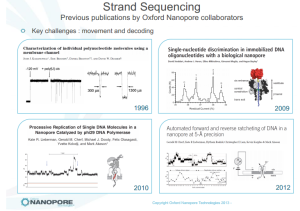
Oxford Nanopore Slides Say 50KB Read Length Easily Obtained
Our earlier post “Everything You Want to Know about Oxford Nanopore”, derived from ONT patents, was possibly the most one could learn about the technology from public sources, but now the company releases a number of helpful slides (h/t: @assemblathon).
Key points -
a) MinION should be able to achieve real time sequencing (1 min sequencing time and less than 1 hour sample-prep).
c) The instrument can easily get 50kB or more read length, but sample preparation limits read length in real experiments.
d) Indel is the primary mode of error.
e) Error-rate is independent of position on the read.
f) They utilize two-pore sequencing strategy with errors from two independent pores canceling each other.
g) Total investment to date - 147M British pounds.
h) The signal to sequence or base-calling workflow ($100M question) is not very clear from the slides. They mention HMM and Viterbi algorithm, which is expected.
The following figure shows the challenges that the company went through over the years. By clicking on the image, you can see the entire presentation.

-—————————————————————————-
Our petition for Lex Nederbragt’s Norwegian Sequencing Center to get early access is still open. Please feel free to sign, if you think the community would benefit from it.

Post: A Petition to Request Early Access to Minion Nanopore for Lex Nederbragts Group
Petition: sign it here